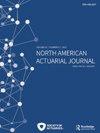A Reverse ES (CVaR) Optimization Formula
IF 1.6
Q3 BUSINESS, FINANCE
引用次数: 1
Abstract
AbstractThe celebrated Expected Shortfall (ES, also known as tail Value at Risk or conditional Value at Risk) optimization formula implies that ES at a fixed probability level is the minimum of a linear real function plus a scaled mean excess function. We establish a reverse ES optimization formula that says that a mean excess function at any fixed threshold is the maximum of an ES curve minus a linear function. Despite being a simple result, this formula reveals elegant symmetries between the mean excess function and the ES curve, as well as their optimizers. The reverse ES optimization formula is closely related to the Fenchel-Legendre transforms, and our formulas are generalized from ES to optimized certainty equivalents, a popular class of convex risk measures. We analyze worst-case values of the mean excess function under two popular settings of model uncertainty to illustrate the usefulness of the reverse ES optimization formula, and this is further demonstrated with an application using insurance datasets. Disclosure statementNo potential conflict of interest was reported by the author(s).Additional informationFundingRuodu Wang acknowledges financial support from the Natural Sciences and Engineering Research Council of Canada (RGPIN-2018-03823, RGPAS-2018-522590).反向ES (CVaR)优化公式
摘要著名的期望缺口优化公式(ES,又称风险尾值或条件风险值)表明,在固定的概率水平上,ES是线性实函数加上标度平均超额函数的最小值。我们建立了一个反向ES优化公式,该公式表明,在任何固定阈值处的平均超额函数是ES曲线减去线性函数的最大值。尽管是一个简单的结果,这个公式揭示了平均过剩函数和ES曲线之间的优雅对称性,以及它们的优化器。反向ES优化公式与fenhel - legendre变换密切相关,我们的公式从ES推广到优化确定性当量,这是一类流行的凸风险度量。我们分析了在两种常见的模型不确定性设置下平均超额函数的最坏情况值,以说明反向ES优化公式的有用性,并通过使用保险数据集的应用进一步证明了这一点。披露声明作者未报告潜在的利益冲突。王gruodu感谢加拿大自然科学与工程研究委员会(RGPIN-2018-03823, RGPAS-2018-522590)的资金支持。
本文章由计算机程序翻译,如有差异,请以英文原文为准。
求助全文
约1分钟内获得全文
求助全文

 求助内容:
求助内容: 应助结果提醒方式:
应助结果提醒方式:


